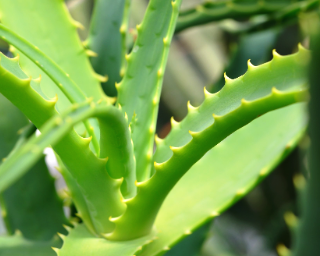Aloe barbadensis (Miller) or Aloe Vera is one of the 400 or more species of Aloe. It is a cactus, a slow-growing perennial succulent plant belonging to the Aloeaceae family (some include it in either the Liliaceae or Asphodelaceae families) that evolved in the arid environments of North Africa.

The most common aloes used in medicine and cosmetics are :
- Aloe barbadensis
- Aloe ferox
- Aloe greatheadii
It can reach 1.5 m in height with a very thick root. The leaves are white-green with spiny teeth on the margins. It matures at 4 years of age and at that age weighs about 1.5 kg, living about 12 years.
The use of herbs is a well-established method for treating certain diseases, but herbs can trigger side effects and can interact with other herbs, supplements or medications. For these reasons, one should only proceed with caution when taking them with the assistance of a doctor (1). In any case, it is important to set quantities and frequency of intake that only a doctor can prescribe.
Latex and gels are made from the plant with a long history of topical and local therapy, as a treatment for burns, wounds, skin irritation and constipation, and in Ayurvedic medicine it is used against skin diseases, however ingestion has been associated with several physical ailments (2).
It abounds in anthraquinones, plant enzymes and useful tricyclic aromatic secondary metabolites, including aloe emodin and chrysophanol (3).
It contains antioxidant vitamins (A, C, E, B12), niacin, riboflavin and folic acid and, used as a laxative stimulant, anthelmintic. It also contains potassium, calcium, magnesium, copper, zinc, chromium, iron and magnesium lactate (4) as well as polysaccharides (glucomannans), amino acids, fatty acids (lupeol and campesterol), lipids, plant sterols, tannins and enzymes (amylase, catalase and peroxidase) used as herbal medicines.
Cosmetics
Skin conditioning agent. An ingredient that is the mainstay of topical skin treatment by restoring, increasing or improving skin tolerance to external factors, including melanocyte tolerance. The most important function of the conditioning agent is to prevent skin dehydration, but the subject is rather complex and involves emollients and humectants.
CAS 85507-69-3 94349-62-9
EC number 287-390-8 305-181-2
Medical
Aloe vera improved epithelialisation and granulation tissue of burn wounds in patients with superficial second degree burns (5) and significantly increased skin elasticity index (6) and collagen levels (7).
Digestive system
Aloe has been used for the treatment of diseases affecting the digestive system and in particular has been closely associated with gastroprotection having demonstrated the potential to alleviate alcohol-induced acute gastric injury (8).
Diabetes
Aloe vera administration has been shown to restore blood glucose levels to normal with a concomitant increase in insulin levels, thereby exerting antidiabetic effects, improving insulin secretion, pancreatic β-cell function and restoring pancreatic islet mass (9).
Bones
The results of this study indicate that Aloe is an excellent source of antioxidant and anti-osteoporotic phytochemicals (10).
Teeth
Aloe vera may prove to be an effective mouthwash due to its ability to reduce dental plaque (11).
The most relevant studies on this ingredient have been selected with a summary of their contents:
Aloe vera studies
References_____________________________________________________________________
(1) Aloe - University of Maryland - Medical Center
http://umm.edu/health/medical/altmed/herb/aloe
(2) Boudreau M, Beland F (2006) An evaluation of the biological and toxicological properties of Aloe barbadensis (miller), Aloe vera. J Environ Sci Heal C 24: 103–154
(3) Enhancement of Anti-Inflammatory Activity of Aloe vera Adventitious Root Extracts through the Alteration of Primary and Secondary Metabolites via Salicylic Acid Elicitation
Yun Sun Lee, Hyun Kyoung Ju, Yeon Jeong Kim, Tae-Gyu Lim, Md Romij Uddin, Yeon Bok Kim, Jin Hong Baek, Sung Won Kwon, Ki Won Lee, Hak Soo Seo, Sang Un Park, Tae-Jin Yang
PLoS One. 2013; 8(12): e82479. Published online 2013 Dec 16. doi: 10.1371/journal.pone.0082479
(4) Shelton M. Aloe vera, its chemical and therapeutic properties. Int J Dermatol. 1991;30:679–683. doi: 10.1111/j.1365-4362.1991.tb02607.x
(5) Irani PS, Varaie S. Comparison of the Effect of Aloe Vera Gel and Nitrofurazone 2% on Epithelialization and Granulation Tissue Formation Regarding Superficial Second-Degree Burns. Iran J Med Sci. 2016 May;41(3 Suppl):S3.
(6) Tanaka M, Yamamoto Y, Misawa E, Nabeshima K, Saito M, Yamauchi K, Abe F, Furukawa F. Aloe sterol supplementation improves skin elasticity in Japanese men with sunlight-exposed skin: a 12-week double-blind, randomized controlled trial. Clin Cosmet Investig Dermatol. 2016 Nov 10;9:435-442. doi: 10.2147/CCID.S118947. Erratum in: Clin Cosmet Investig Dermatol. 2016 Dec 16;10 :1.
(7) Tanaka M, Yamamoto Y, Misawa E, Nabeshima K, Saito M, Yamauchi K, Abe F, Furukawa F. Effects of Aloe Sterol Supplementation on Skin Elasticity, Hydration, and Collagen Score: A 12-Week Double-Blind, Randomized, Controlled Trial. Skin Pharmacol Physiol. 2016;29(6):309-317. doi: 10.1159/000454718.
(8) Park CH, Son HU, Yoo CY, Lee SH. Low molecular-weight gel fraction of Aloe vera exhibits gastroprotection by inducing matrix metalloproteinase-9 inhibitory activity in alcohol-induced acute gastric lesion tissues. Pharm Biol. 2017 Dec;55(1):2110-2115. doi: 10.1080/13880209.2017.1371770.
(9) Noor A, Gunasekaran S, Vijayalakshmi MA. Improvement of Insulin Secretion and Pancreatic β-cell Function in Streptozotocin-induced Diabetic Rats Treated with Aloe vera Extract. Pharmacognosy Res. 2017 Dec;9(Suppl 1):S99-S104. doi: 10.4103/pr.pr_75_17.
(10) Sun YN, Li W, Lee SH, Jang HD, Ma JY, Kim YH. Antioxidant and anti-osteoporotic effects of anthraquinones and related constituents from the aqueous dissolved Aloe exudates. Nat Prod Res. 2017 Dec;31(23):2810-2813. doi: 10.1080/14786419.2017.1295238.
(11) Gupta RK, Gupta D, Bhaskar DJ, Yadav A, Obaid K, Mishra S. Preliminary antiplaque efficacy of aloe vera mouthwash on 4 day plaque re-growth model: randomized control trial. Ethiop J Health Sci. 2014 Apr;24(2):139-44. doi: 10.4314/ejhs.v24i2.6.
![]() Aloe Barbadensis Leaf Juice
Aloe Barbadensis Leaf Juice 


